New to the hobby and want to learn more but don't know where to start? You've come to the right place. Aside from our site, we have listed some of important links to help you build out your perfect home for your new amazing friends.
General Dart Frog Care
What Do Dart Frogs Eat?
For Dart Frogs, Drosophila melanogaster, Hydei, or Turkish Glider fruit flies are the preferred food for all dart frogs.
Supplementary foods for Dart Frogs may include: Crickets, Bean Beetles, Springtails, Isopods, Termites, and Pea Aphids
Dart frogs will need to be fed a few times per week and require vitamins and minerals to be dusted with every meal. If you have to go out of town for a week or more, it is recommended you have someone drop by and help feed your buddies. We can help you find fruit flies locally. You can also try to leave a fruit fly cup with the lid off inside the vivarium to seed the tank for the week, but they won’t get vitamins so this can be dangerous to do often.
As a treat you may feed dart frogs larger prey such as pinhead crickets, 1/8 inch crickets or bean beetles, however the extra chitin has been known to contribute to digestive issues and possible prolapse. We can help you if something does go wrong, don’t hesitate reaching out or looking at our health section for medicine
Your Darts will also feast on springtails and isopods but they are not a sufficient food source, kind of like eating potato chips for dinner every night…

Dart Frog Care Videos
Must Have
Vitamins (calcium – every feeding, Vitamin-A, once a month or twice a month for breeding frogs, and a multivitamin – once every week or two), Leaf Litter, isopods and springtails, live plants, sphagnum moss, basic lighting, feeder source, room temperature location, basic sealed vivarium at least 10 gallons
Nice to have
Accent plants, cork hides, plant lights, sliding glass door vivariums with venting, circulation fans, plumbing and automatic misting systems. Multiple types and brands of feeders and vitamins, carotenoid color enhancers
Really Shouldn’t Have
Water features, short or small (less than 18″x18″x24″) tanks, multiple species or locales, or more than one frog per 5 gallons, letting it get dry, put in plants that will get huge, getting a heater, putting in plants that were not sanitized, smoke, candles, spray cleaners or aerosol chemicals.
Dart frogs sold by Frogsdirect.com are completely harmless to humans, but tiny insects beware. You should never touch a dart frog with your bare hand, as you can harm them with the oils in your skin. We only sell Captive bred frogs to the public unless otherwise specified.
Wild caught species should be considered expert level ONLY. We also encourage our breeders to include information on the origin of the frogs listed.
There are lot's of resources out there that can explain better than my words, so check out these YouTube videos that explain it all. Careful, you may get caught going down a rabbit hole here!
First, we have Troy Goldberg's Tropical Garage. If you are not subscribed, you need to be, Troy brings some really amazing builds to life on his channel and is an expert with over a decade of tank building and frog rearing success.
Where We Live on a Map

- Dendrobates auratus
- Oophaga pumilo "Blue Jeans"
- Ameerega bassleri
- Dendrobates tinctorius
- Epipedobates anthonyi
- Oophaga histrionica
- Phyllobates terribilis
- Phyllobates bicolor
- Phyllobates aurotaenia
- Ranitomeya benedicta
- Ranitomeya fantastica
- Ranitomeya lamasi
- Dendrobates leucomelas
- Dendrobates tinctorius
- Mantella aurantiaca
- Mantella baroni
- Mantella bernhardi
- Mantella cowanii
- Mantella expectata
What our Habitat Looks Like
photos courtesy of Daniel Kimball, shot in Brazil and Colombia around 2017-2020.

